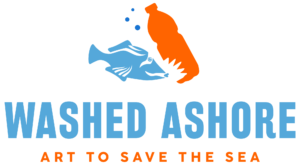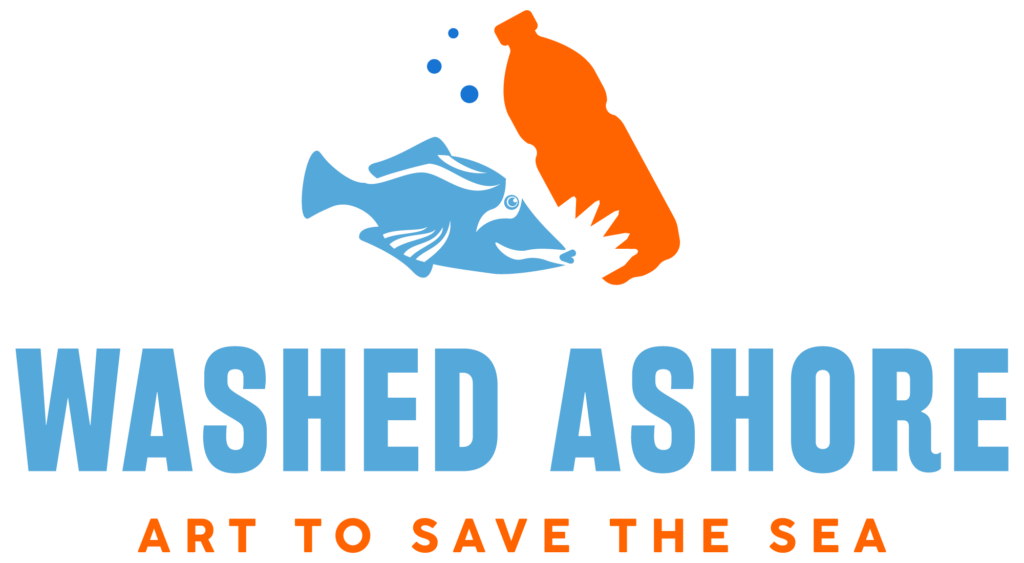In November 2021, Norfolk Botanical Gardens debuted the unveiling of a year long, nationwide collaborative project to create Washed Ashore’s nationwide pandemic project, Rosa the Bald Eagle. Rosa is a nine foot tall Bald Eagle with a 15 foot wingspan and weighs approximately 2000 pounds. Rosa was constructed entirely from pieces of plastic marine debris sorted and assembled by thousands of volunteers across the United States.
When the Covid-19 pandemic led to a national lockdown of indoor spaces in early 2020, the Washed Ashore gallery and art studios were affected much like everyone else. Volunteer activity ceased, exhibits were closed, and workshops were emptied. Washed Ashore relies heavily on a steady stream of volunteers to collect and sort debris and build parts of sculptures, accompanying our full-time staff of artists and helpers. But overnight, our doors were closed and volunteers sent home.
Knowing the problems of plastic ocean pollution were too great to ignore, Washed Ashore looked to find a creative way to continue our mission to create ‘Art to Save the Sea’ and finding a way to still work together, but differently.
“Everyone working together can make big amazing things happen,” is often said by Washed Ashore founder and Artistic Director Angela Haseltine Pozzi. And so we got to work, calling on supporters and putting together a plan to unite us as the pandemic kept us all apart.
Spreading our wings
To bring a country together during times of hardship, Washed Ashore opened our determined efforts nationwide with a goal to work together and create a new sculpture, a symbol of unity. What better symbol of hope and unity for the people of the United States than a giant American Bald Eagle, the symbol of our democracy?
The project was named “Come Soar With Us”, by our Executive Director Katie Dougherty and our team got to work putting together detailed plastic debris construction kits and instructions and mailing them out across America to over 1,550 volunteers across seven states. Their tireless participation stretched well over eight months, creating the feathers for what would be become Rosa’s impressive wingspan.
At Washed Ashore, this project was a way to bring our country back together when we all needed a feeling of resilience. During a time when so much was halted, the momentum and collaboration from creating Rosa with all of our staff and volunteers was inspiring and has given our team an enormous sense of pride and accomplishment.
Our Volunteers Made It Happen
Thank you to our contributing volunteers, your time and efforts have not only created a beautiful and captivating sculpture, you have also made a difference to bring awareness to growing plastic pollution problem in our oceans and waterways. Over 1000 pounds of debris was used to create Rosa, including 4,000 volunteer-made feathers. Norfolk Botanical Garden alone completed over 700 feathers with hundreds of volunteers.
Hundreds of others participated as well including:
- John Ball Zoo in Michigan
- Turtle Bay Exploration Park in California
- Eaglebrook School in Deerfield, Massachusetts
- Students from the Washington School for the Blind in Vancouver, WA
- Ten Families in Brooklyn, NY
- Four Oregon Elementary Schools
- Dozens of volunteers throughout the West
- Many hometown residents here in Bandon, OR
Facts about Rosa
- Rosa’s name comes from the great women’s rights activist Rosa Parks, who spent her life fighting for equal rights. The name Rosa, an international name, also pays homage to the many immigrants who have helped create and support our nation for hundreds of years.
- Rosa is a Bald Eagle not only because of our national bird, but also because Bald Eagle conservation is one of the great success stories of recent times. Bald Eagles were once pushed to the edge of extinction from our society’s use of pesticides and sport hunting. When we passed laws to protect the environment, Bald Eagle populations rebounded. They are now a symbol of resilience as well as strength.
- Rosa is depicted pulling a large fish from the water with her giant claws. This reminds us of plastic in the food chain; fish are eating plastics, and eagles are eating fish.
- Rosa is 9.5 ft. tall x 17 ft. long x 7.5 ft. wide.
- She is estimated to weigh around 2,000 lbs.
- She has a welded stainless-steel base covered in tires as base plastic. Marine debris is then cut, wired, and screwed on to depict the textures, colors and patterns of feathers, fish scales and water.


